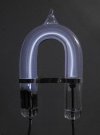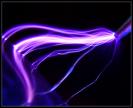



Physics -- the mother of natural sciences
All natural sciences in some way are based upon the cumulative results of centuries of research in the area of physics. In the far past, there was only a distinction between the science of the living things/beings and the science of the non-living things. Only during the 18th and 19th centuries, scientists were distinguishing between different parts of the natural sciences, simply because the field of science became too broad to be covered completely. But still, physics can be regarded as the mother of all natural sciences. The phenomena, studies in chemistry, astronomy, but even in biology, can only be understood in a fundamental way by understanding the underlying physics.
For this reason, a good amateur science site cannot be without physics. Unfortunately, the real interesting and novel physics experiments are beyond the reach of amateur scientists. Where chemistry can be done at a fairly high level by a home chemist, this is much more difficult for physics. Good physics experiments require specialized (and expensive) apparatus. An exception, at least to some extent, is for the physics of electricity. Also for the amateur, experiments can be done at an affordable price. Many physics experiments on this site, for this reason, are experiments with electricity, but there also are some other simple experiments, which nevertheless are quite interesting and show some fundamental concepts of the world around us.
In the physics section, there also will be a set of very interesting simulations, based on physical models, combined with good numerical algorithms for analyzing and simulating these models. Some really interesting results can be obtained from very simple models, and these results also can be connected to real-world physical processes.
![]() The
experiments-section gives a number of
experiments. Some experiments are performed with real physical components and
apparatus, other experiments are simulations of simple, but still very
interesting models.
The
experiments-section gives a number of
experiments. Some experiments are performed with real physical components and
apparatus, other experiments are simulations of simple, but still very
interesting models.
![]() Finally, the
miscellaneous section contains general
resources, which may be of interest for the amateur scientist. Topics, covered
there are, among others, suppliers of equipment, electronic components, some theory
and software.
Finally, the
miscellaneous section contains general
resources, which may be of interest for the amateur scientist. Topics, covered
there are, among others, suppliers of equipment, electronic components, some theory
and software.

Safety
Some of the experiments, described on this website, are extremely dangerous, if not performed by people, who know what they are doing. Some of these dangerous things can even be done without expensive equipment, but I want to give a word of warning: When you are not comfortable with the physics behind the risky experiments, and you are not experienced with handling dangerous apparatus and setups, then do not attempt to repeat the experiment yourself. This is a serious warning. I cannot take any responsibility for injury, or even loss of life, due to performing dangerous physics experiments! Some of the experiments in the physics section of this website are the most dangerous of this website. Especially very high voltage/high power experiments are among the most dangerous things one can do at home, and these are even more dangerous than certain chemistry experiments with very explosive or toxic compounds.

Disclaimer
Although the author believes that the information on this site is useful and may lead to good results, the author cannot bear any responsibility for any losses or injuries, resulting from the use of the information from this site. The following disclaimer holds for the entire physics section of this site:
Neither the author nor the publishers of the information provided on this site may be held responsible or liable for the use of this information. It may not be assumed that all necessary warnings, and precautionary measures, are contained on this site or that any such information provided is up-to-date or correct.